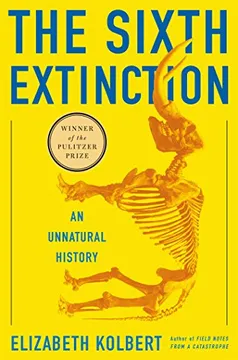The Sixth Extinction: A Call to Reality

The book “The Sixth Extinction” by Elizabeth Kolbert is a very interesting and thought-provoking read that discusses mass extinctions that have happened throughout history on our planet and the current extinction crisis caused by humans. The book has a lot of well-researched information that is presented in a clear and easy to understand manner. It is an excellent book for people who are interested in science, biology, and the environment.
Kolbert takes the reader on a journey through time, starting with the extinction of dinosaurs and working her way through the five previous mass extinctions that have occurred in the history of Earth. She explains how each extinction event was caused by a combination of natural disasters, such as volcanic eruptions and asteroid impacts, and gradual changes in the environment.
However, Kolbert argues that the current extinction crisis is different. This time, the cause of the extinction is not natural, but rather, it is caused by human activities such as deforestation, pollution, and climate change. She provides compelling evidence of how human activities are driving countless species to extinction at an unprecedented rate.
One of the most interesting aspects of the book is how Kolbert blends science with storytelling. She travels to different parts of the world, from the Great Barrier Reef to the Amazon rainforest, to meet with scientists and researchers who are working to understand the extent of the current extinction crisis. Through her conversations with these experts, she helps the reader understand the complexities of the issue and the urgency of the situation.
Kolbert’s writing is easy to read and understand, making the book accessible to both scientists and nonscientists. She uses vivid language and storytelling to bring the science to life, making it easy for the reader to understand complex concepts. She also provides a historical context for the extinction crisis, explaining how humans have been altering the planet for thousands of years.
One of the most impactful chapters in the book is “The Madness Gene.” In this chapter, Kolbert explores the role of human psychology in causing the extinction crisis. She argues that humans have an innate tendency to prioritize short-term gains over long-term consequences, which has led us to exploit the planet’s resources without regard for the consequences. She also explores the idea of the “Anthropocene,” the proposed new geological era in which human activities are the dominant force shaping the planet.
Another chapter that stands out is “The New Pangaea.” In this chapter, Kolbert explores how human activities are causing species to move and adapt in ways that could lead to a reshuffling of the world’s ecosystems. She describes how species are moving to new areas to escape the effects of climate change, and how this movement could lead to the formation of new communities of species.
One of the strengths of “The Sixth Extinction” is that it does not just present a problem without offering solutions. Kolbert explores various strategies for mitigating the extinction crisis, from conservation efforts to the development of new technologies. She also highlights the important role that individuals can play in reducing their impact on the environment.
Despite overwhelming evidence that human actions are causing mass extinctions, our response to this crisis and the broader climate emergency has been painfully slow. This is largely due to an outdated perspective on our relationship with the environment. However, history has shown that when faced with clear choices between right and wrong, humanity has the ability to overcome even the most challenging problems.
Even though there is a compelling argument that what we are doing to cause the current mass extinction is unequivocally wrong. The evidence presented is too significant to ignore, and it is clear that our path forward must involve accelerating the transition to a more sustainable world. Only by recognizing the urgency of this issue and taking decisive action can we hope to mitigate the devastating consequences of our actions and protect the Earth’s biodiversity for future generations.
Kolbert’s book not only identifies the problem but also offers a glimmer of hope by outlining various strategies to address the extinction crisis. By highlighting the role of conservation efforts and the development of new technologies, as well as emphasizing the individual responsibility to reduce our impact on the environment, she demonstrates that we still have a chance to make a positive impact. Ultimately, “The Sixth Extinction” is a powerful wake-up call that inspires action and advocacy for the protection of our planet’s biodiversity.
Overall, “The Sixth Extinction” is a powerful book that provides a sobering look at the current state of the planet. It is a call to action for all of us to take responsibility for our actions and work together to protect the planet’s biodiversity. While the book can be unsettling at times, it is ultimately a message of hope, as Kolbert demonstrates that it is not too late to make a difference. The book is a must-read for anyone who cares about the environment and the future of the planet.



